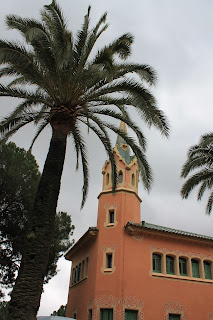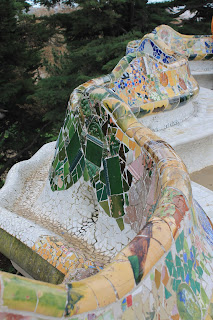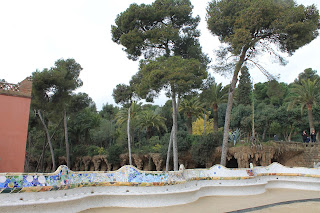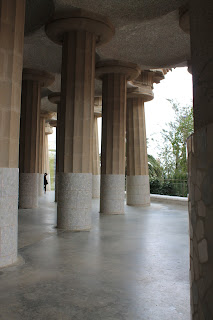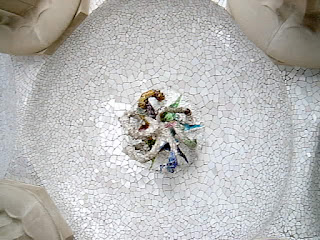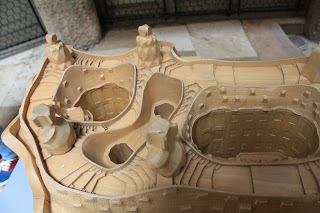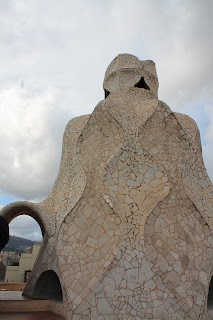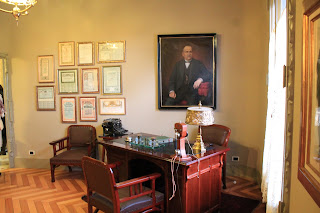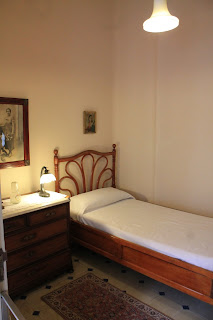Der Haupteingang wird von zwei Pförtnerhäusern flankiert, mit Dächern, die wie leckeres Backwerk aussehen. Dann gelangt man zur Haupttreppe, die vom Drachen bewacht wird und weiter geht es zum Untergeschoss des Terrassenplatzes, das als eine Art Markthalle von Gaudí geplant war. Ein großes Areal das von hundert Säulen getragen wird und mit den für Gaudís Arbeiten typischen Bruchkeramikmosaiken verziert ist. Weiter die Treppe hoch und man ist auf der Terrasse, als Theaterplatz geplant, wird das Oval heute durchaus für kulturelle Veranstaltungen genutzt. Platz für viele Zuschauer ist auf der 152 Meter langen Bank, die sich einmal um den Platz schlängelt. Die Wellenbank ist in der Grundfarbe weiß und mit dekorativen Dekors aus abstrakten Mustern, Blumen, Vögeln, Sternzeichen, Fischen, Krebsen verziert und das Regenwasser läuft über durchaus lustige Wasserspeier ab....
Und weil es ein regnerischer Tag war, saß niemand dort und ich konnte mir die ganze Bank ganz lange ganz viel ansehen, toll.
Gaudí war innovativ wie immer, umweltfreundliches und nachhaltiges Bauen war hier sein Grundsatz, die Hügellandschaft wurde kaum verändert, sondern der Park der Natur angepasst, die Majolika Designs der langen Bank wurden aus Bruchstücken und Abfällen aus den umliegenden Keramikfabriken hergestellt.
Es ist Gaudís farbenprächtigste Schöpfung und ein schöner grüner Ort mit vielen blühenden Gehölzen und vom Oval hat man einen überwältigenden Blick auf die Stadt.
And again Gaudí, can´t get enough. This time a client wanted a park, Count Eusebio Güell loved to live in the countryside since he had sawn english parks and Gaudí came along with a vision of a city in a green area, with 60 villas wich shall surround a park with a greek inspired central place like a amphitheater. Like often the basic was missed, the money, and only three houses were build, the Villa Güell, today a school, the house for Gaudí, today the Casa-Museu Gaudí and another living house wich is still in use.
The main entrance is flanked by two porter's lodges, with roofs looking like tasty cupcakes. Than you reach the main stair, guided by the dragon and it leads to a big hall supposed to be a marketplace in Gaudí's vision. A big areal with a ceilling borne by hundred pillars and decorated with the typical artwork of fragments of pottery always to be found in Gaudí's creation. And again on with the stairs and you reach the top of the hall, an oval, what was planned as the theater and is used sometimes somehow as cultural place. It is much space for the audiance, they may sit on the longest bench (152 metres), shaped like waves, made of white pottery and decored with abstract pattern, zodiac signs, flowers, fishes, crabs and birds, and the rain water is flowing down through quiet funny gargoyles.....
and it was a rainy day, so no people were sitting on the bench and I could see the whole one as long as I wanted, cool.
Gaudí was breaking new grounds as always, ecofriendly and long lasting building was his credo, he didn't change the landscape, but adapted the park to the nature, the Majolika Design was made of the waste and the broken tiles of the nearby pottery factories.
It is Gaudí's most colorful creation and a beautiful green place with blooming trees and from the oval you have a beautiful view on the city of Barcelona.

















